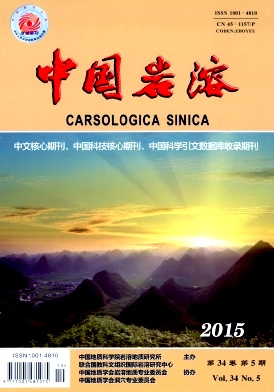LONG Si, CHEN Zhong-ji, ZHOU Yun-chao, ZHANG Chun-lai. Preliminary research on dissolution of carbonate rocks and major element release under the conditions of stagnant water and dripping water[J]. Carsologica Sinica, 2015, (5): 452-459. doi: 10.11932/karst20150505
| Citation: |
LONG Si, CHEN Zhong-ji, ZHOU Yun-chao, ZHANG Chun-lai. Preliminary research on dissolution of carbonate rocks and major element release under the conditions of stagnant water and dripping water[J]. Carsologica Sinica, 2015, (5): 452-459. doi: 10.11932/karst20150505
|
Preliminary research on dissolution of carbonate rocks and major element release under the conditions of stagnant water and dripping water
-
Abstract
To further understand the dissolution of carbonate rock and the release of the major elements un-der the different conditions of stagnant and dripping water,three types of carbonate rock samples,i.e.dolo-mite,calcite dolomite,and limestone,were collected from Guizhou University South Campus in Huaxi dis-trict of Guiyang City,Jiangjun hill and Huaxi reservoir,respectively,to conduct the tests of soaking them in stagnant water and splashing them by dripping water.The dissolution of four major elements potassium (as K),phosphorus (as P),calcium (as Ca)and magnesium (as Mg)for each type of rock under each condition were measured.The results showed that:(1)at the same temperature 25 ℃,when soaking for 20 days,the highest dissolved amount on all four elements occurred in dolomite,i.e.K-0.00138 μg/ cm3 ,P-0.0006μg/cm3 ,Ca-1 99.75 μg/cm3 and Mg-70 μg/cm3 .Also,the dissolution of Ca were the highest in all three types of carbonate rocks, i.e. 1 99.75 μg/cm3 in dolomite, 148.42 μg/cm3 in calcite dolomite and 137.88 μg/cm3 in limestone,which was far higher than other three elements.(2)When soaking at different temperatures,the dissolution of K increased with temperature in all three types of carbonate rocks.At the temperature between 10 ℃ and 20 ℃,the dissolution rate of K reached to the maximum,while the dissolu-tion of P showed very little response to temperature change.In terms of the constituent contents in the sam-ples,K in dolomite and P in limestone had the lowest value;however,their dissolution was the largest when temperature increases.(3)Under the condition of rock soaking in stagnant water,the dissolution of most el-ements in dolomite was higher than other two types of carbonate rock.However,under the condition of splashing by dripping water,the dissolution of Mg was higher in dolomite than in calcite dolomite and lime-stone while the dissolution of all other three elements was higher in limestone.Under the condition of drip-ping water,with the increase of dripping time,the dissolution of Ca had increased by 2.55 times in one hour,which far exceeded the dissolution of Ca in dolomite.
-

-
-
Access History







 DownLoad:
DownLoad: